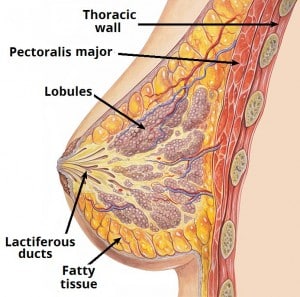Lactation is the maternal physiological response whereby milk is secreted from the mammary glands to feed the infant.
In this article, we will cover the synthesis and regulation of milk production and also the let-down reflex that releases milk.
Breast Development
The mammary glands are embedded in the breasts. The mammary gland comprises 15-20 lobulated masses of tissue with fibrous tissue connecting the lobes and adipose tissue in between. The lobes are made up of alveoli, blood vessels and lactiferous ducts.
At birth, there are only a few ducts present and at puberty, oestrogen causes the ducts to sprout and the ends form masses of cells that later become alveoli. With each menstrual cycle, there are cyclic changes due to changes in oestrogen and progesterone.

Fig 1 – Internal structure of the breast
During Pregnancy
During pregnancy, there is significant hypertrophy of the ductular-lobular-alveolar system, prominent lobules form and from mid-gestation alveolar cells differentiate to be capable of milk production.
There is little milk secretion due to the high progesterone:oestrogen ratio which favours growth rather than secretion.
Lactogenesis
The alveolar epithelial cells responsible for milk production are polarised, highly differentiated cells and their function is to accumulate, synthesise, package and export the components of milk:
| Water | 90% |
| Lactose | 7% |
| Fat | 2% |
| Protein | 1% |
| Minerals | 0.2% (Ca2+, Fe, Mg, K, Na, P, S) |
| Vitamins | A, B, B2, C, D, E, K |
| pH | 7.0 |
| Energy Value | 27 MJ.I-1 |
Table 1 – The composition of mature milk
Soon after birth, the breasts produce 40ml/day of colostrum. This has less water-soluble vitamins, fat and sugar than mature milk, but contains more proteins (particularly immunoglobulins) and fat-soluble vitamins.
Regulation of Milk Production
Regulation of quantity and content of milk is largely under hormonal control, primarily prolactin.
During pregnancy, a high progesterone:oestrogen ratio favours the development of alveoli, but not secretion. With the delivery of the placenta, the source of the large amount of circulating steroids (more so progesterone) is removed allowing the alveoli to respond to prolactin. Breast milk begins to form within 24 – 48 hours.
Prolactin is a polypeptide hormone and is secreted by the anterior pituitary gland. This is controlled by dopamine (also known as Prolactin Inhibiting Hormone) from the hypothalamus (inhibits prolactin). Factors promoting the secretion of prolactin reduce dopamine secretion in a negative feedback loop. It is also produced by decidual cells.
Prolactin stimulation is promoted by suckling and is a neuroendocrine reflex. Suckling mechanically stimulates receptors in the nipple and impulses pass up to the brain stem and to the hypothalamus to reduce the secretion of dopamine and increase vasoactive intestinal protein (promotes prolactin secretion).
Suckling at one feed promotes prolactin release, which causes production for the next feed which accumulates in alveoli and ducts (turgor).
Milk Let-Down Reflex
Mechanical stimulation of the nipple is responsible for milk delivery to the infant and maintenance of lactation. Babies do not suck the milk out of the breast, it is ejected by the let-down reflex.
In response to suckling, oxytocin is released from the pituitary gland which stimulates myoepithelial cells that surround alveoli to contract thus squeezing milk out of the breast.
Despite suckling being the major stimulus for milk let-down, the reflex can be conditioned. The cry or sight of an infant and the preparation of the breast for nursing may cause let-down, whereas pain, embarrassment or alcohol may inhibit it.
Maintaining Milk Production
The key to maintaining milk production is sufficient suckling stimulation at each feed to maintain prolactin secretion and remove accumulated milk. If suckling stops, milk production decreases gradually. This is due to turgor-induced damage to secretory cells and low prolactin levels. Milk suppression can also be achieved via steroids.
Prolactin secretion during lactation reduces fertility and so makes a new pregnancy less likely until the infant stops suckling.
Clinical Relevance – Hyperprolactinaemia
Hyperprolactinaemia is a condition in which there are elevated prolactin levels and can cause infertility, low sex drive and bone loss in men and women. This is usually due to a prolactin-secreting tumour of the pituitary gland (prolactinoma) but can be medication-induced, as a result of hypothyroidism or idiopathic.
Dopamine-receptor agonists (bromocriptine/cabergoline) are used to treat hyperprolactinaemia but are usually discontinued once pregnancy is confirmed. However, these drugs may be electively continued in cases of prolactinoma to prevent tumour expansion.
Dopamine agonists are safe to take during breastfeeding, however, since they suppress lactation, mothers might find breastfeeding difficult or impossible unless these drugs are discontinued before birth.
